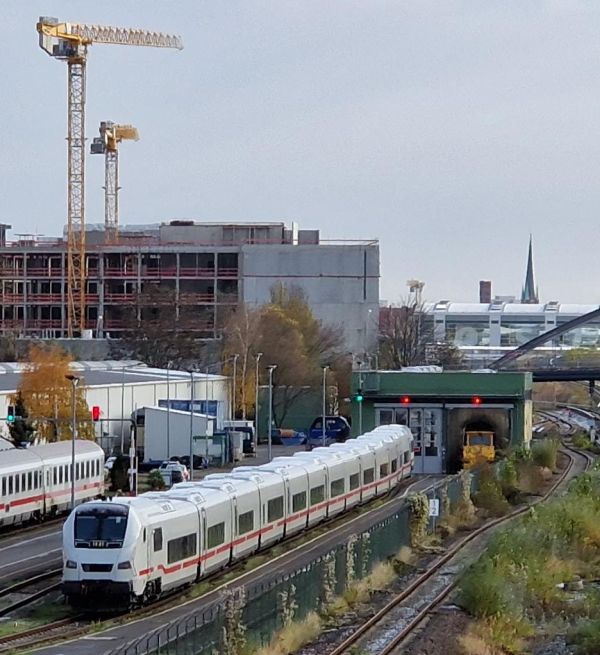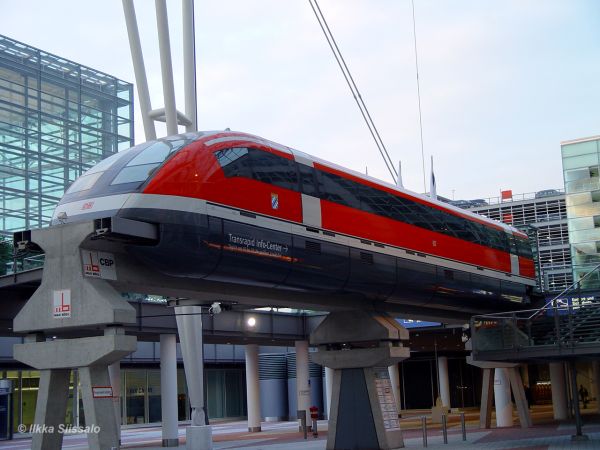

Germany is one of the most interesting railroading countries in modern history.
Not only while it has such a wide variety of private railroad companies in addition to the still huge state owned Deutsche Bahn AG (DB),
but also while its many rail operators constantly buy and change their trains, keep renting them for short periods and giving
them thereafter to even new operators. Many of the private locomotives change their looks several times a year - a fact that also
makes it very difficult for the occasional photographer to figure out what the train is. Often the stickers by the sides of the
trains are from some previous owner or renter.
But also Germany's state railways Deutsche Bahn AG is interesting - and huge. The multitude of trains is vast, and what is also
typical of Germany is, that even to be able to understand their railroad related magazines (of which there is a wonderful multitude)
you need to understand not only the language, but you also need to know by heart which Baureihe (class) is which. This - of course
- does not have to be explained to anyone (!!). It's taken for granted :-)
Our title picture shows the first ICE-L trainset. ICE stands for Intercity Express and L means low-floor. DB has ordered these new
ICE-L wagonsets from the Spanish company Talgo. Talgo is famous for its proprietary trainsets where coaches are permanentltly fixed
with each other, coaches are also shorter than standard passenger wagons and they lack normal bogies. Instead there is just one
individual axle located between the wagons.
In this collection of German trains we try to show as many of the different classes as we can. This is your lession one: Baureihe or Br = class.
Here we see this first ICE-L wagonset still without DB's logos, parked at Talgo's own depot in Berlin. The first trials have only now started.
Picture from Talgo's depot in Berlin 25.11.2023 by Matti Heino.
FUNET railway pictures archive - Germany
Picture categories
- Electric locomotive hauled trains of DB and DB Cargo
- Electric multiple units of DB
- Diesel locomotive hauled trains of DB and DB Cargo
- Diesel multiple units and railbuses of DB
- InterCity Express ICE trains of DB AG
- S-Bahn of Berlin
- S-Bahn of Hamburg
- Tram-train lightrails
- Old steam locomotives of DB and DR
- Rail tractors and other rail maintenance vehicles
- DB subsidiaries Mitteldeutsche Eisenbahn MEG, Euro Cargo Rail, RBH Logistics
- DB Oberweissbacher Berg- und Schwarzatalbahn, mountain railway in Thüringen
German state railways Deutsche Bahn AG DB
-
Foreign states rail companies and their subsidiaries in Germany
- Belgian SNCB in Germany
- Czech state railways Ceské dráhy
- DSB of Denmark incl. Vias rail
- French SNCF + subsidiaries Captrain and ITL
- GoAhead Germany, now owned by ÖBB of Austria
- CFL of Luxembourg and its subsidiaries in Germany
- Abellio, a subsidiary of Dutch state railways NS
- PKP of Poland in Germany
- SBB of Switzerland and its subsidiaries in Germany
- FS Trenitalia, the Italian state railways and its subsidiaries
-
Other private rail operators in Germany
- Agilis
- Cantus Verkehrsgesellschaft
- Erfurter Bahn
- Eisenbahnen und Verkehrsbetriebe Elbe-Weser GmbH evb, Mittelweserbahn, Metronom and enno
- Europorte, cargo trains through the Channel tunnel and to France
- Flixtrain, private long distance trains operator
- Hessische Landesbahn HLB
- Transdev group of companies (ex-Connex, ex-Veolia)
- ALEX, Allgäu Express, Arriva Länderbahn Express
- SWEG and HzL, Südwestdeutsche Landesverkehrs-AG incl. Hohenzollerische Landesbahnen
- Small private cargo operators
- Small private passenger train operators
-
Narrow gauge railways
- Harzer Schmalspurbahnen
- Rügensche Bäderbahn, Rasender Roland
- Härtsfeldbahn
- Öchslebahn
-
Other rail related pictures
- Miscellaneous
- Trams in Germany
- Tram-train light rail systems in Germany
- Metro trains in Germany
- The Bavarian railway museum, Bayerisches Eisenbahnmuseum in Nördlingen
- The Wuppertaler Schwebebahn, a hanging train
This is a German speciality, a Transrapid magnetic levitation (Maglev) train. For quite some time, Germany had a trial track with several wagons close to the Dutch border, where magnetic levitation train technology was tried out. The trials ended in a tragic collision where several people lost their lives. A Maglev train floats in the air carried by a very strong magnetic field, which means that there is no friction whatsoever between the train wagon and the track, so that huge speeds can be reached. But the technology also has its limitations: the Maglev coaches cannot be very long and several coaches cannot be run very close to one another, so that the actual capacity counted in passing passengers per hour is not very large despite the huge speed. For a while one of the Transrapid maglev train wagons was set on display together with a very short piece of the track that it needs at the Frankfurt airport. This is a picture from that display, taken in 2007 by Ilkka Siissalo.

